The first blockbuster science fiction film of 2022 has hit theaters: Moonfall, which tells the story of the Moon falling out of orbit and threatening Earth with a catastrophic extinction event. Films like this often contain many dramatic elements, but they also raise numerous questions for us. For example:
What would happen if our atmosphere were suddenly ripped apart, and oxygen began to escape into space like a punctured air cushion? Is the Moon an artificial satellite, completely hollow and disguised by alien technology?
Could the U.S. government prevent an impending cosmic disaster simply by firing a nuclear missile into the core of the Moon, a massive satellite?
But Moonfall also poses a very practical question that astronauts and health monitors at NASA face daily: What happens if they have diarrhea in space?
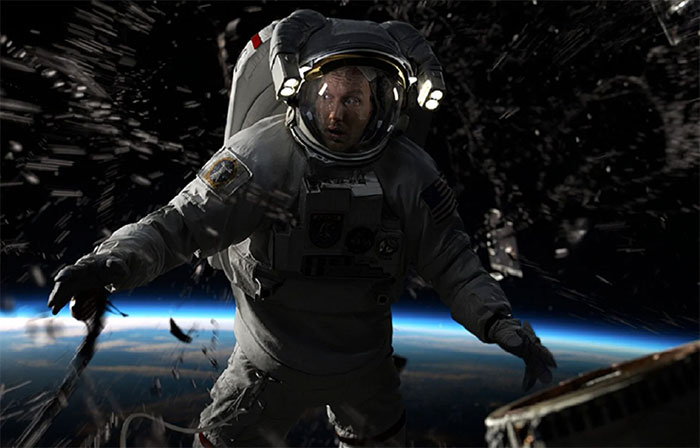
Due to various reasons, some cases of diarrhea have been reported on space flights.
It should be noted that the film does not depict this scenario realistically. However, it leaves open the possibility of a character, an unwilling astronaut suffering from Irritable Bowel Syndrome (IBS), having to board a spacecraft immediately without time to use the restroom.
The likelihood of him experiencing diarrhea up there is quite high. Fortunately, “IBS is not a disqualifying factor preventing you from going to space or applying for an astronaut position at NASA,” said Mika McKinnon, a scientific advisor for Moonfall, a geophysicist and disaster researcher.
According to a risk report published by NASA’s Human Research Program in 2016, “for various reasons, some cases of diarrhea have been reported on space flights.”
But the report stops there, providing only a brief informational line. We do not know which astronauts actually experienced diarrhea, on which flight or mission, making it impossible to interview them.
Thus, the quickest approach is to consult NASA’s doctors, who take care of every aspect of the astronauts’ health, including their gastrointestinal issues.
1. Astronauts Must Schedule Bathroom Breaks
Josef Schmid, a doctor at NASA, confirms that the U.S. space program has accounted for all issues related to bowel movements, including instances of astronauts having diarrhea.
Everyone has digestive issues from time to time, whether they are astronauts or ordinary people, Schmid says. “One thing I was taught back in medical school, which I still remember to this day: No one is truly perfectly healthy; there are just people we haven’t examined thoroughly yet.”
In reality, even the healthiest astronauts can experience involuntary bowel movements, just like most people with irritable bowel syndrome on the ground.
How do astronauts use the restroom in space?
The problem is that on the International Space Station (ISS), there are only two toilets, and both have been known to malfunction at times. The number of astronauts on the ISS typically ranges from 6 to 7, peaking at 13. Therefore, astronauts often have to schedule their bathroom breaks to avoid overlapping.
It may seem strange to have to schedule restroom breaks, but it is considered part of their workday. On the ISS, everything, every task, is scheduled very clearly.
Ironically, using the restroom is not something you want to have to do. Thus, most astronauts must push hard when they go. Dr. Schmid states that despite the scheduling, no one can maintain a perfect bathroom schedule. Therefore, astronauts are encouraged to fully empty their bowels during their scheduled bathroom breaks.
The opposite is also true; there are times when you will have to hold it until your turn. But if you are genuinely experiencing diarrhea and need urgent access to the restroom, you will have to negotiate with the astronaut currently inside, who is also trying to push during their break.
2. Astronauts Are More Prone to Constipation Than Diarrhea
“As a NASA doctor, one of the questions I ask astronauts every day after they reach orbit is: ‘How are you eating?’. The next question is ‘Are you having regular bowel movements?’“, Schmid says.
He adds that most astronauts experience constipation in the early days of orbit. This is because these flights put them in stressful situations. Stress can disrupt the digestive system in both directions, causing either diarrhea or constipation. Gravity and dietary habits are additional factors that push astronauts toward constipation.
Specifically, during the launch to orbit, astronauts must sit in a position with their legs at heart level. This position causes fluids to accumulate, making them feel the urge to urinate. Therefore, to avoid the urge occurring during critical moments, astronauts often limit their water intake before their launch day.
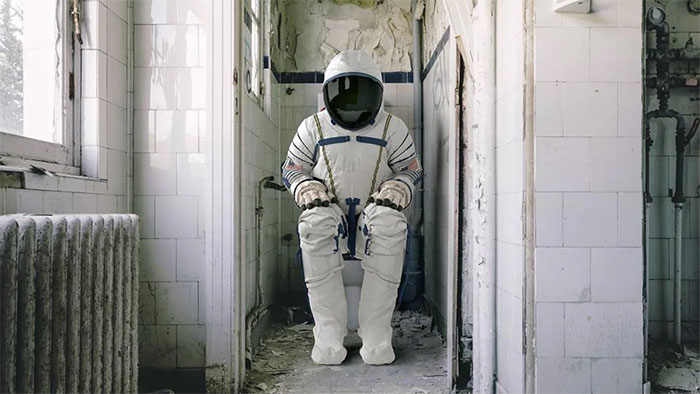
Astronauts often limit their water intake before their launch day.
Drinking less water can lead to constipation, and thus, the first few days on the ISS are often challenging for astronauts in terms of bowel movements. Fortunately, NASA schedules lighter workloads for them during those days.
Therefore, astronauts can feel reassured if they cannot fully empty their bowels during their scheduled breaks; they can return during another shift to do so, as long as it does not overlap with other astronauts’ schedules.
3. Free-Floating Feces in Spacecraft
Returning to the launch from Earth to orbit, the question arises: what if an astronaut cannot hold it? In reality, on launch vehicles like Russia’s Soyuz, astronauts must wear super-absorbent diapers, which they can urinate into.
As for bowel movements, they have a commode. Astronauts are instructed to wrap a three-layer plastic bag around the commode, relieve themselves into it, and then seal the waste. However, going back to the Apollo missions of the 1960s and 1970s, crew members didn’t even have a commode.
They were simply instructed to stick a plastic bag directly to their behinds and defecate into it. And during the journey from Earth to the Moon, the microgravity environment would cause feces to float. Astronauts would have to use their hands to catch it. Of course, usually, they only touched the outside of the bag.
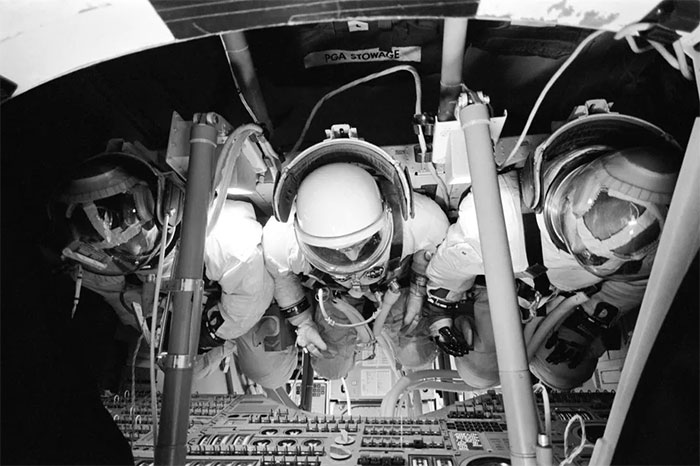


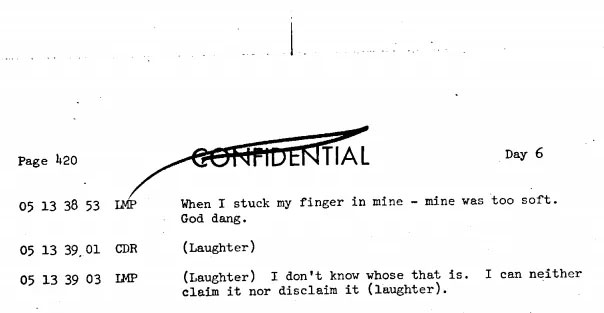
The floating feces incident on Apollo 10 and the declassified conversation from NASA.
As a result, there was a peculiar incident during the Apollo 10 mission when astronauts found a floating clump of grass inside the spacecraft. This caused commander Tom Stafford to exclaim: “Oh, who did that?“
Ultimately, no one claimed responsibility, and the source of the grass remains a mystery. But you can guess that if an astronaut allows their feces to float in the air, even just a little, grass could sprout from it.
4. Astronauts’ Feces Are Released into the Atmosphere and Burn Like Shooting Stars
Today, to minimize issues related to feces in space, astronauts are often given laxatives before launch. This helps them avoid the urgent need to relieve themselves during the flight.
The entire ISS crew must also adhere to a strictly monitored diet and hydration schedule. Partly to maintain their health, but also to ensure that restroom usage goes smoothly.
“All astronauts must go through training on how to use the restroom“, Dr. Schmid laughs. The toilet on the ISS is different from those on the ground; it works like a vacuum cleaner and can suck waste inside.
With the suction power of this machine, the spacecraft can avoid incidents similar to what occurred on Apollo 10. But both Schmid and McKinnon try to explain that the vacuum does not simply suck astronaut waste and blow it out into space.
This is because feces and urine can easily accumulate close together and stick to the outer surface of the spacecraft or satellite. Instead, waste on the International Space Station (ISS) is packaged and then transferred to cargo ships that continue to supply the astronauts.
When the spacecraft returns to the atmosphere, all the waste is released, and it burns up during this process like shooting stars.
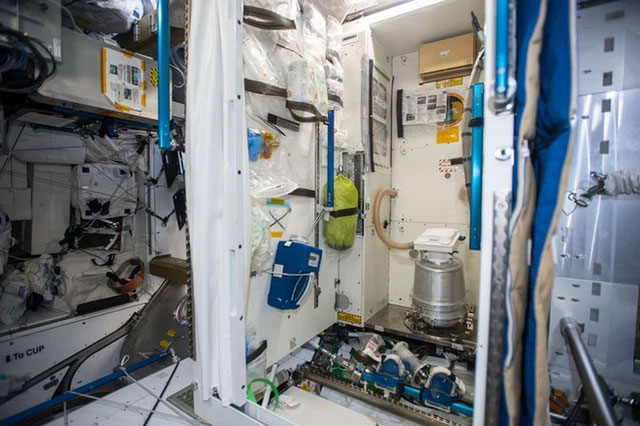
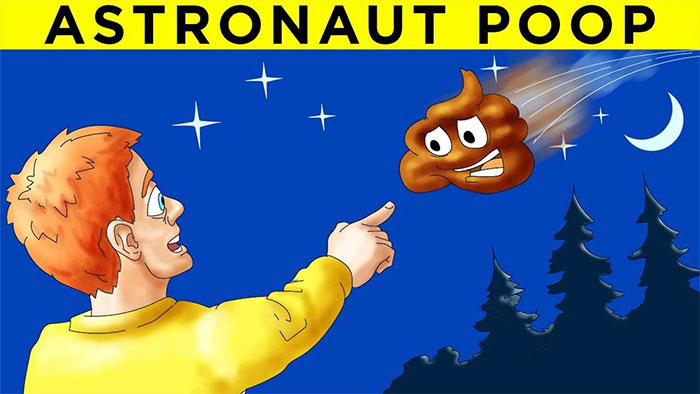
When the spacecraft returns to the atmosphere, all the waste is released.
Returning to the movie “Moonfall,” it seems that the astronauts used an old-fashioned spacecraft similar to those in the Apollo missions. Therefore, if the unfortunate amateur astronaut suffers from diarrhea on the trip from Earth to the Moon, he would be guided by the main character (a veteran NASA astronaut) on how to use a plastic bag taped to his rear.
However, he must also be warned to be careful; otherwise, grass might grow all over their spacecraft.




















































